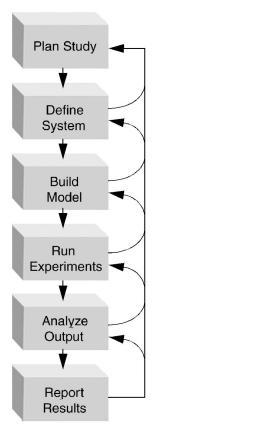
You are here: Planning the Model > Steps for Doing Simulation > General Procedure
A decision to do a simulation usually results from a perception that simulation can help resolve one or more issues associated with the design of a new system or the modification of an existing system. Before launching into a simulation project, one or more individuals should have been assigned to the study who have at least a basic knowledge of the system to be studied and the issues of concern. Enough background information should have been obtained about the nature of the problem to determine whether simulation is a suitable solution. If the simulation is being conducted by individuals inside the company, there may already be a basic knowledge of the operation. For outsiders or those unfamiliar with the operation, a brief description of the system and explanation of key issues should be provided. For an existing system, a facility walk-through is an excellent way of getting familiar with the operation.
Once a suitable application or project has been identified as a candidate for simulation, decisions must be made about how to conduct the study. There are no strict rules on how to perform a simulation study, however, the following steps are generally recommended as a guideline (Shannon, 1975; Gordon, 1978; Law, 1991):
1. Plan the study
2. Define the system
3. Build the model
4. Run experiments
5. Analyze the output
6. Report results
Each step need not be completed in its entirety before moving on to the next step. The procedure for doing a simulation is an iterative one in which activities are refined and sometimes redefined with each iteration. Describing this iterative process, Pritsker and Pegden (1979) observe the following.
The iterative nature of this process is shown next:

While the requirements for each step vary from simulation to simulation, the basic procedure is essentially the same. The primary value of adopting this systematic procedure, or one like it, is to ensure that the project is conducted in an organized, timely fashion with minimal waste of time and resources and maximum effectiveness in achieving the objectives.